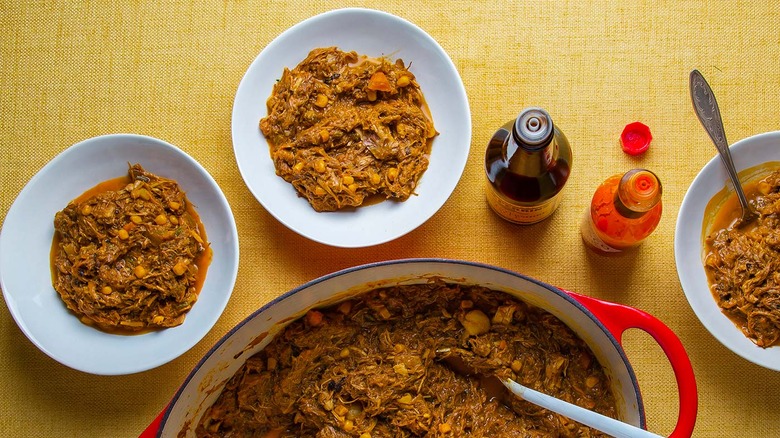Burgoo And The Kentucky Derby History
This stew is even more essential to the annual event than mint juleps and fancy hats
The fancy hat-clad masses are making their way to Churchill Downs for the Kentucky Derby, that famous annual tradition. And while you're probably familiar with classic Louisville fare, like the bourbon-heavy mint julep and the open-faced, Mornay sauce-drenched Hot Brown, you may not know about the event's other quintessential culinary tradition: burgoo.
Burgoo is a rich, hearty stew typically made with some combination of meat, vegetables and barbecue sauce, and is one of those traditional Kentucky dishes that's so widespread there's no consensus on its origins. Some say it was invented by a Frenchman named Gus Jaubert during the Civil War, made with whatever gamey meat, like squirrel and foul, he could scrounge up as a meal for soldiers. Others say it was the invention of freed slaves, who would make big batches of burgoo for livestock sales. And yet another theory claims the dish can be traced back to Native Americans, who prepared it as a hunting stew. The name itself was likely born from a mispronunciation of bird stew or barbecue.
The common thread through all of these stories, though, is that burgoo is a dish that was created out of necessity. There is no singular way to prepare it—and as Danielle Bell, a baker originally from Louisville, puts it, "It's not an especially posh dish." Its contents are dependent only on what ingredients you happen to have around, and that's the beauty of it. "It's an approachable, everyman dish that is accessible to all," Allison Casale of Old Hickory BBQ in Owensboro, Kentucky, says. "It's fitting, since Kentucky is a commonwealth state."
Burgoo first became associated with racing when the dish was served at livestock sales in the early 1800s. A horse-racing tradition began as a means to convince people to buy the animals, and these events became wildly popular gathering places for friends to catch up and for politicians to connect with supporters. Traveling cooks, seeing an opportunity, started preparing burgoo at these racing events in enormous batches and selling it to onlookers.
Eventually, when the Kentucky Derby was established in 1875, the tradition of burgoo was transferred over to the racecourse. These days, the most famous spot to enjoy burgoo during the racing season is Keeneland Racecourse, where the qualifying rounds for the Derby are held. Since the 1930s, the track has been serving the same recipe for Kentucky burgoo, with pork, thyme, sage, garlic, carrots, corn, okra and Worcestershire sauce, all cooked for hours in an enormous kettle. The burgoo is so popular that Keeneland goes through between 90 and 100 gallons of the stew each day of race week, according to Marc Therrien, Keeneland's executive chef.
Alex Huber, a publicist originally from Kentucky, says that Keeneland burgoo was a huge part of her upbringing, "As a young girl going to Keeneland with my parents and crumbling saltines into the Styrofoam cup, or when I was older, doing the same as an elixir for a few too many bourbons."
There was even a legendary American Thoroughbred racehorse named Burgoo King (which was also supposedly the nickname of a talented burgoo cook named J. T. Looney) who won the Kentucky Derby in 1932.
Outside the Keeneland Racecourse, plenty of restaurants throughout the state still make burgoo the traditional way. In western Kentucky, burgoo has long been served as an accompaniment to barbecue, and Old Hickory BBQ makes its version using a 100-year-old recipe comprising of mutton, plus seasonings like apple cider vinegar and cayenne. At Wallace Station in Versailles, chef Ouita Michel does a version of burgoo with pork butt, slow-cooked beef chuck, chicken, rabbit, Worcestershire sauce and Crystal hot sauce.
RELATED Get Your Julep On This Derby Day at Louisville's Top Bars "
Other places bring the stew into the fine dining realm especially for Derby season. Dudley's on Short in Lexington, for example, serves a deconstructed version with lamb loin, cornbread fried mutton and a rabbit croquette.
But the way Michel sees it, to intentionally try to make burgoo look fancier defeats the whole purpose of the dish.
"Burgoo is a communal dish—it's defined by community," she says. "You don't make it deconstructed or in small quantities." Burgoo is essential to Derby not because the meat is particularly flavorful or the presentation is uniquely ornate. "It's a dish that's filled with so much memory," she adds. "It's been made by so many different groups of people. That multidimensional story is what makes it special and an essential part of who we are in Kentucky."
Priya Krishna is a food writer who contributes to The New York Times, The New Yorker, Bon Appétit and others. Her latest cookbook, Indianish, will be released in spring 2019.
